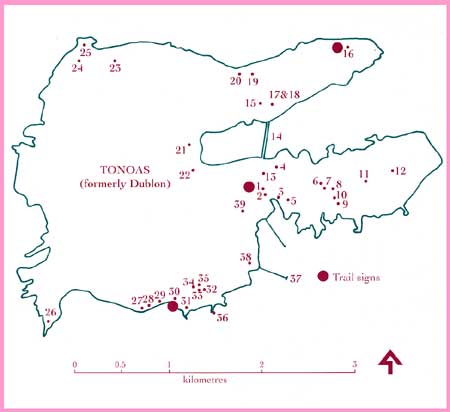| The War in the Pacific |
|
War in Paradise Tonoas (Dublon), Japanese World War II Headquarters in Chuuk 
This description of some of the remaining World War II sites on Tonoas is based on information from eight Chuukese men, who lived on Tonoas during the war. These men are some of the chiefs of Tonoas, being Tong Misa, of Nechap and Chairman of the traditional chiefs of Tonoas; Menis Nion, of Wonpiepi, Kuchua; Ysauo Reseky, of Wonpiepi, Kuchua; Repin Emmanuel, of Penienuk, Enin; Minoru Kuka, of Tonof, Kuchua; Yoda Chaniel, of Sapou, Kucha; Werner Walter, of Fankachaw; and Joshua Suka, Guide/Interpreter. Gradvin Aisek, Mayor of Tonoas, was instrumental in this work and in encouraging the chief's to tell their stories, as well as telling his own. They all have good and bad memories about the Japanese periods, before and during the war. For instance, Tong worked for the Japanese Navy and was a deck hand on the small supply lighters that serviced the mercantile and military fleet. During this time, he went aboard the Yamato, Admiral Yamamato's flagship and he observed the Admiral ashore on Tonoas. Joshua Suka, who can read and write Japanese was a seal-maker's apprentice, until the seal-maker returned to Japan. He became the chief maker of seals for all the Japanese that were required to use an identifying seal to get paid. Tonoas, the traditional name for the island called Dublon during the war, was the location for the Japanese military and civil administration of Chuuk before, and during World War II. Tonoas was extensively modified leading up to, and during the war. Land was reclaimed, trees and vegetation were cleared, and traditional historic sites were interfered with. The massive migration of Japanese onto Tonoas had a big effect on the Chuukese living there. Before the war, under military (Navy) administration from 1914 to 1922, then civilian administration from 1922 to about 1937, Japanese and Chuukese lived reasonably comfortable together. The Japanese provided Chuukese with work, education and health, and as in other colonial settings, alienation of Chuukese land, and the breakdown of Chuukese traditional lifestyles commenced. The war changed this delicate relationship, many Chuukese were forced from their homes, and the island itself; education stopped; forced labour was introduced to carry-out the many military construction projects; and the breadfruit, coconut and banana trees were either cut-down or made unavailable for Chuukese consumption. During the war Tonoas was a hive of activity. A civilian township comprising all the facilities to expect of a small town, called Dublon Town was located in the southeast section of the island. The Japanese Fourth Fleet was based on Tonoas and they established buildings and facilities, many of them were prefabricated wooden structures, built onto concrete foundations with a tin roof. There was also a submarine base, a seaplane base, a number of very large fuel tanks, and a repair facility for vessels. There was also a number of small and large buildings established as 'comfort houses' where women were forced to entertain Japanese men. The island contains numerous guns that were used in its defence, as well as many small and large tunnels to shelter people, equipment and munitions from the bombing. Information on a number of World War II sites follow. It is not an exhaustive list of all the war remains. It is hoped this work will lead to an appreciation and understanding of the World War II history of Tonoas, and as a representation of all of Chuuk, at a time of terrible suffering for its indigenous inhabitants.
|

